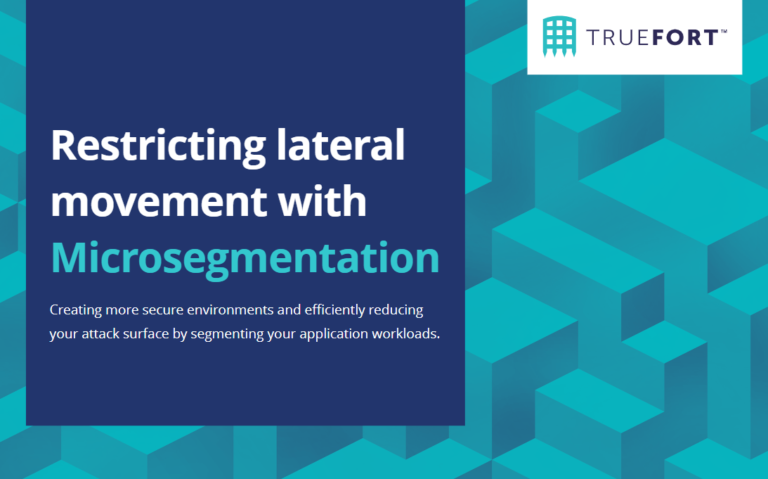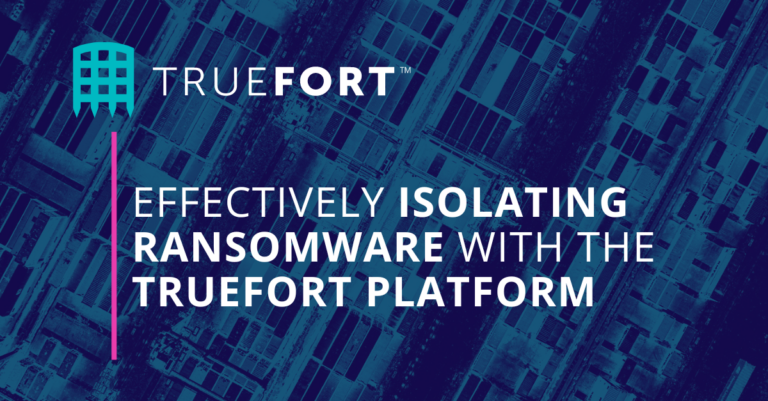TRUEFORT SOLUTION
Enterprise-grade Ransomware Protection Software
Threat actors and cybercriminals have grown more capable, frequent, and successful in ransomware attacks. Entering via a vulnerability and moving undetected, exploiting user credentials, legacy systems, and misconfigurations, ransomware spreads at will. TrueFort isolates ransomware from reaching critical workloads by only allowing previously understood application and workload behavior.
Detect initial ransomware compromise before it spreads.
- Slow, meaningless detection – Ransomware doesn’t mind if you detect it. It often announces itself after spreading broadly across the entire environment in a few minutes.
- Complex application and workload environments – Organizations are challenged with understanding what constitutes normal application activity including communications Between them, processes that execute, and the service accounts running privileged commands.
- Vulnerable, unsupported systems – Legacy systems are inherited, acquired, or minimally supported and often forgotten until they are encrypted to cause an outage.

The race to detect and stop before devastation
Understand relationships
Discover and map the full environment to understand relationships between applications, workloads, and service accounts while verifying that cross-communications are valid and acceptable by generating an application baseline
Hardened systems
Implement CIS benchmarks and best practice file configurations to prevent unauthorized changes that make workloads more vulnerable to the tools ransomware uses to automatically spread
Prevention of unnecessary actions
Use approved baselines of workload behavior to enforce policies that block unknown malicious behavior before it’s known to threat intelligence
Automate enforcement
Block unauthorized network connections between applications, disable incorrectly used privileged accounts, or kill unknown processes as they execute to minimize the blast radius
FAQ
Protecting against ransomware requires a proactive and multi-layered approach to safeguard an organization’s critical data and systems. Here are key strategies to consider:
- Regular Data Backup: Maintaining regular offline backups of critical data ensures the ability to restore systems without paying a ransom.
- Employee Education and Awareness: Training employees on safe computing practices, recognizing phishing attempts, and avoiding suspicious email attachments or links can help prevent initial infection vectors.
- Patch Management: Promptly applying security patches and updates across all systems and software reduce the risk of exploitation by ransomware.
- Robust Endpoint Protection: Deploying advanced endpoint protection solutions, including next-generation antivirus and behavior-based detection, helps detect and block ransomware threats.
- Network Segmentation: Isolating critical systems and limiting lateral movement through network segmentation prevents the rapid spread of ransomware.
- Email Filtering and Web Security: Implementing robust email filtering and web security measures helps block malicious attachments, links, and websites hosting ransomware.
- Incident Response Planning: Developing a comprehensive incident response plan, including ransomware-specific procedures, facilitates timely detection, containment, and recovery in the event of an attack.
- Security Awareness Testing: Conducting periodic security awareness testing, such as simulated phishing campaigns and red team exercises, helps identify areas for improvement and reinforces a security-conscious culture.
By adopting a holistic approach that combines these preventive measures, organizations can significantly enhance their resilience against ransomware threats, reducing the potential for data loss, financial impact, and operational disruptions.
Detecting ransomware attacks promptly is crucial for organizations to mitigate any potential damage. Here are a few key strategies to detect ransomware:
- Endpoint Monitoring: Deploying endpoint detection and response (EDR) solutions helps monitor and analyze endpoint activities, enabling the detection of suspicious behaviors indicative of ransomware.
- Network Traffic Analysis: Utilizing network monitoring tools to analyze traffic patterns and anomalies can help identify indicators of ransomware activity, such as communication with known malicious domains or unusual data transfers.
- Anomaly Detection: Implementing advanced anomaly detection mechanisms, such as user behavior analytics (UBA), aids in identifying unusual activities and deviations from normal patterns that could indicate ransomware activity.
- File Integrity Monitoring: Monitoring changes to critical files and systems through file integrity monitoring (FIM) solutions can detect unauthorized modifications typically associated with ransomware attacks.
- Security Information and Event Management (SIEM): Leveraging SIEM platforms enables the correlation and analysis of security events from various sources, providing insights into potential ransomware incidents.
- User Reports and Phishing Awareness: Encouraging employees to report suspicious emails or activities, combined with ongoing phishing awareness training, can assist in the early detection of ransomware attempts.
Through a combination of these detection strategies and establishing a robust incident response plan, organizations can swiftly identify and respond to ransomware attacks, minimizing the impact and potential loss of data and resources.
In short, yes. Ransomware can be detected through various proactive measures and advanced security solutions. While ransomware attacks continue to evolve and become more sophisticated, organizations can implement strategies to detect its presence. By employing endpoint monitoring tools, network traffic analysis, anomaly detection mechanisms, file integrity monitoring, and robust security information and event management (SIEM) systems, organizations can identify indicators of ransomware activity.
Promoting user awareness, encouraging reporting of suspicious activities, and fostering a strong security culture can all aid in the early detection of ransomware attempts. However, it is important to note that maintaining a multi-layered defense approach and regular updates to security measures are essential in combating evolving ransomware threats.
Resources












